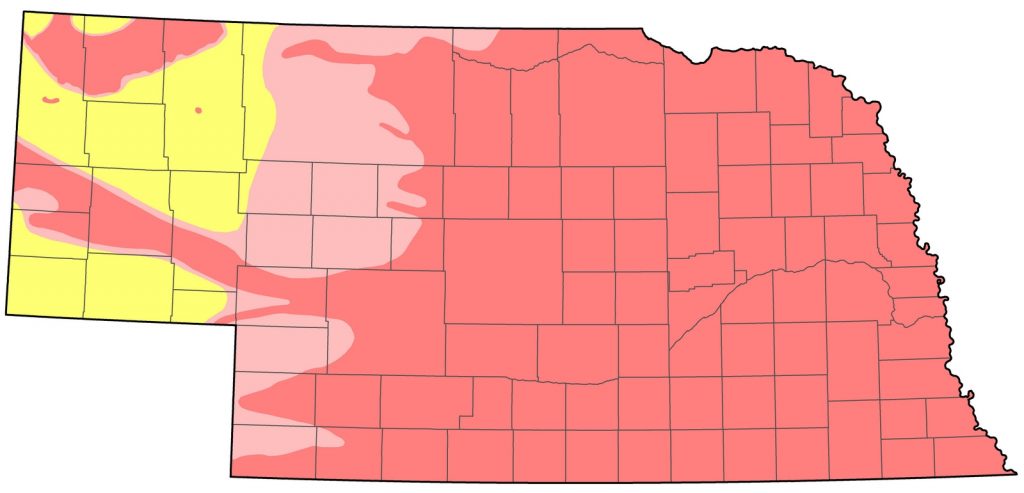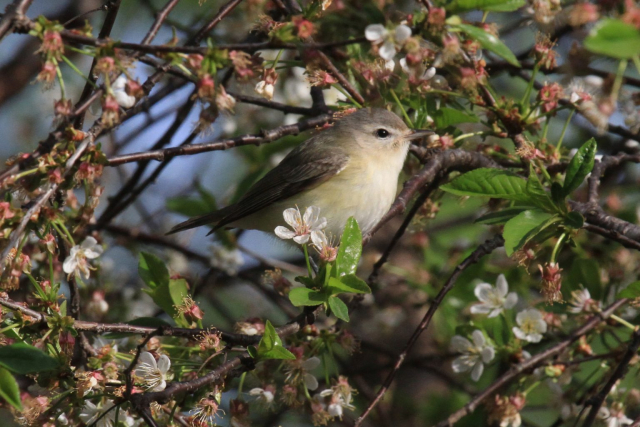Vireo gilvus gilvus, V. g. brewsteri
Status: Common regular spring and fall migrant statewide. Common regular breeder east and east-central, uncommon west-central and west.

Documentation: Specimens: UNSM ZM6788, 23 May 1900 Monroe Canyon, Sioux Co (brewsteri) (Bruner, handwritten annotation in his copy of Bruner 1896 in possession of WRS); UNSM ZM6789, 26 Apr 1901 Lancaster Co (gilvus).
Taxonomy: Five subspecies are recognized (AviList 2025), three of which occur north of Mexico: swainsonii, from southeast Alaska to southern Northwest Territories south to California, brewsteri, from southern Idaho and western South Dakota south to Arizona and southwest Texas, and gilvus, from south-central Alberta south to Louisiana and east to Maine and North Carolina.
AOU (1998) places these subspecies in two groups, “western” (swainsonii) and “eastern” (gilvus); the western group includes swainsonii and brewsteri, and the eastern group gilvus. It has been suggested that the two groups may be separate species; a proposal before the NACC of AOS (Cicero 2025) noting the two groups differ in several ways including morphology, genetics, and song has not been decided upon.
Two subspecies occur in Nebraska, brewsteri and gilvus. It seems clear that the breeding Warbling Vireos in the Pine Ridge are western brewsteri based on the specimen cited above and Bruner et al (1904), who stated “So far it has only been found in Sioux county [sic], where it is common and breeds.” This is the breeding subspecies of the Black Hills of South Dakota (Tallman et al 2002). A statement that it breeds at “Crescent Lake” (AOU 1957) has not been substantiated. The only records of brewsteri away from the Pine Ridge are during migration (see Spring, Fall), although there are a few summer (Jul-early Aug) records (see Summer).
Eastern gilvus occupies most of the rest of the state although its western limits are uncertain. In the north, it summers west to Valentine and Merritt Reservoir SRA, Cherry Co but is rare in the western Sandhills and Panhandle away from the North Platte River Valley, with only two regular locations, the deciduous “oases” at Agate, Sioux Co and Smith Lake WMA, Sheridan Co. The only Pine Ridge reports of gilvus are at Fort Robinson SHP, Dawes Co 20 May 2015 (Rick Wright, personal communication; vocalizing) and 18 Jun 2015, possibly the same individual (eBird.org), although one was at Box Butte Reservoir, Dawes Co 3 Jul 2020. A series of eBird reports by Steve Mlodinow and Michael Willison at various locations in the southwest sheds some light on western limits there: eastern gilvus occurred in good numbers in Dundy, Chase, Keith, and extreme southeast Garden Cos 26-27 May 2019, and in 2020 Mlodinow reported up to five at several locations in Garden, Keith, Chase, and Dundy Cos 7 Aug-4 Sep; it is known to occur commonly in the South Platte River Valley into Colorado (Leukering and Mlodinow 2017).
The above distributional information suggests that there is minimal overlap in breeding season ranges of eastern gilvus and western brewsteri Warbling Vireos in Nebraska; the shortest distances between them appear to be the 80 miles (125 km) from Valentine, Cherry Co to the eastern Pine Ridge and the 35 miles (60 km) from the Pine Ridge to the North Platte River Valley. Nevertheless, recordings of singing birds in the Panhandle and west-central Nebraska are needed to discern the relative breeding distributions of the two subspecies.
Spring: gilvus: Apr 20, 20, 21 <<<>>> summer (east, central); Apr 26, 27, 27 <<<>>> summer (west); brewsteri: May 8, 8, 11 <<<>>> Jun 13, 13, 14 (away from Pine Ridge)
An earlier date for gilvus is 14 Apr 2012 Dodge Co, and for brewsteri 1 May 2025 Scotts Bluff Co.
Migration data indicate that western subspecies brewsteri arrives about a month later in the Panhandle than presumed eastern gilvus. Away from the Pine Ridge, there are these later reports of presumed migrant brewsteri: one at Oliver Reservoir, Kimball Co 1 Jun 2022, 13 Jun 2022 Scottsbluff WTP, Scotts Bluff Co, four at Scotts Bluff WTP, Scotts Bluff Co 14 Jun 2021, up to four there through 13 Jun 2022, and up to four there during summer 2023 (see Summer). One was singing (compared with singing gilvus) at Ash Hollow SHP, Garden Co 9 Jun 2021.
A study by Jorgensen and Brenner (2024) found that spring arrival dates had advanced by five days from 1938 to 2024.
- High counts: 100+ at Twin Lakes, Lancaster Co, 6 May 2000, 84 at Fontenelle Forest, Sarpy Co 12 May 2018, 42 in Furnas Co 29 May 2005, and 40 at Medicine Creek Reservoir, Frontier Co 27 May 2001.
Summer: Data from BBS routes and eBird show that Warbling Vireos breed statewide, with somewhat lower densities in the Panhandle and the western Sandhills. BBS trend analysis (Sauer et al 2020) shows an average annual increase of 0.97% (95% C.I.; 0.15, 1.81) statewide 1966-2019. Breeding season reports of birds identified as western brewsteri are limited to the Pine Ridge (see below). Birds identified as eastern gilvus occur regularly west to the Valentine area in Cherry Co in the north and Keith Co in the south, with few reports in the intervening western Sandhills (eBird.org, accessed Sep 2023), although one was at Gordon, Sheridan Co 23 Jun 2024. Bray (1994) stated that the species was not known to breed at NNF Halsey, Thomas Co, where it was a migrant only. Eastern gilvus breeds from Keith Co along the South Platte River Valley well into the eastern plains of Colorado, where it occurs in riparian cottonwood/willow habitat (eBird.org; Leukering and Mlodinow 2017). Two gilvus were at Lake Ogallala, Keith Co 24 Jul 2016 and one was “told by song” near Ogallala, Keith Co 15 Jun 2017.
There are eight mid-summer (15 Jun-30 Aug) records of brewsteri away from the Pine Ridge that might suggest either occasional breeding away from the Pine Ridge or early departure from the breeding range. Intriguingly, there were reports at Scottsbluff WTP, Scotts Bluff Co 23 Jun (song was difficult “to place” (Mlodinow, eBird.org)), 13 Jul, and 21 Jul 2023 and in 2024 23 Jun-18 Jul. Other reports are 3 Jul 2020 Box Butte Reservoir, Dawes Co, 4 Jul 2020 Pumpkin Creek, Banner Co, 13 Jul Lake Minatare, Scotts Bluff Co, 30 Jul 2019 Kiowa WMA, Scotts Bluff Co, 5 Aug 2021 Cheyenne Co, and 10 Aug 2021 Oliver Reservoir, Kimball Co.
- Breeding Phenology:
Nest building: 8 May-4 Jun
Eggs: 3-19 Jun - Nestlings: 17 Jun
Fledglings: 29 Jun-28 Jul
Fall: gilvus: summer <<<>>> Sep 29, 29, 30 (east, central); summer <<<>>> Sep 20, 21, 22 (west); brewsteri: Aug 30, 31, 31 <<<>>> Sep 14, 15, 15 (away from Pine Ridge)
Later dates in the east and central are 3 Oct 2020 Buffalo Co, 5 Oct 2022 Sarpy Co, 6 Oct 2021 Webster Co, 7 Oct 2021 Lancaster Co, 8 Oct 2015 Douglas Co, 9 Oct 2021 Knox Co, 10 Oct 2015 Merrick Co, 13 Oct 1934 Webster Co (Ludlow 1935), and one extremely late that was banded at Neale Woods NC, Douglas Co 17 Nov 2001 (Betty Grenon and Craig Hensley, personal communication).
Later dates in the west are 25 Sep 2008 banded Scotts Bluff Co, 27 Sep 2021 Kimball Co, 27 Sep 2024 Kimball Co, and 1 Oct 2021 (2) Fort Robinson SP, Dawes Co.
Earlier dates for brewsteri are 17 Aug 2022 (4) Scotts Bluff Co, 21 Aug 2001 Kimball Co (Stephen J. Dinsmore, personal communication), and 25 Aug 2022 Sioux Co. There are scarce data on early departure dates in fall for western brewsteri; later dates in Jul cited above (Summer) may also be of migrants.
Later days for brewsteri are 20 Sep 2022 Oliver Reservoir, Kimball Co, and 29 Sep 2022 in Kimball, Kimball Co.
Five of seven birds netted at Oliver Reservoir, Kimball Co 31 Aug 2000 were brewsteri, and two netted there 21 Aug 2001 were also brewsteri (Stephen J. Dinsmore, personal communication). A brewsteri was photographed at Chadron SP’s banding station 3 Sep 2014 (LeFever 2014).
A banding record of interest is of a Warbling Vireo banded 20 May 1979 at Norfolk, Madison Co, Nebraska and recovered in Guatemala, where this species winters, 8 Oct 1982.
- High counts: 67 at Schuyler, Colfax Co 7 Sep 2014, 50 in Dakota Co 6 Sep 2014, 17 at Ponca SP, Dixon Co 2 Sep 2018, and 17 at Conestoga Lake, Lancaster Co 8 Sep 2024.
Images
Abbreviations
AOS: American Ornithological Society
AOU: American Ornithologists’ Union
BBS: Breeding Bird Survey
NACC: North American Classification Committee
NC: Nature Center
NNF: Nebraska National Forest
SHP: State Historical Park
SP: State Park
SRA: State Recreation Area
UNSM: University of Nebraska State Museum
WMA: Wildlife Management Area (State)
WTP: Water Treatment Plant
Literature Cited
American Ornithologists’ Union [AOU]. 1957. The AOU Check-list of North American birds, 5th ed. Port City Press, Baltimore, Maryland, USA.
American Ornithologists’ Union [AOU]. 1998. The AOU Check-list of North American birds, 7th ed. Allen Press Inc., Lawrence, Kansas, USA.
AviList Core Team, 2025. AviList: The Global Avian Checklist, v2025. https://doi.org/10.2173/avilist.v2025.
Bray, T.E. 1994. Habitat utilization by birds in a man-made forest in the Nebraska Sandhills. Master’s thesis, University of Nebraska-Omaha, Omaha, Nebraska, USA.
Bruner, L., R.H. Wolcott, and M.H. Swenk. 1904. A preliminary review of the birds of Nebraska, with synopses. Klopp and Bartlett, Omaha, Nebraska, USA.
Cicero, C. 2025. Treat Warbling Vireo Vireo gilvus as two species. NACC proposal 2025-C-3.
Jorgensen, J.G., and S.J. Brenner. 2024. The changing spring migration patterns of selected bird species in Nebraska 1938-2024. Joint Report of the Nongame Bird Program at the Nebraska Game and Parks Commission and Audubon Great Plains, Lincoln, Nebraska, USA.
LeFever, J. 2014. Checklist S19659130: Chadron SP–Banding Station Area, Dawes County, Nebraska, US. eBird.org, accessed 4 Jun 2018.
Leukering, T., and S.G. Mlodinow. 2017. Selected Bird Subspecies of Interest in Colorado: Part 1. Colorado Birds 51: 154-169.
Ludlow, C.S. 1935. A quarter-century of bird migration records at Red Cloud, Nebraska. NBR 3: 3-25.
Phillips, A.R. 1991. The known birds of North and Middle America. Part 2. Published by the author, Denver, Colorado, USA.
Sauer, J.R., W.A. Link, and J.E. Hines. 2020. The North American Breeding Bird Survey, Analysis Results 1966 – 2019: U.S. Geological Survey data release. https://doi.org/10.5066/P96A7675.
Sibley, C.G., and B.L. Monroe, Jr. 1990. Distribution and taxonomy of birds of the world. Yale University Press, New Haven, Connecticut, USA.
Tallman, D.A., D.L. Swanson, and J.S. Palmer. 2002. Birds of South Dakota. Midstates/Quality Quick Print, Aberdeen, South Dakota.
Recommended Citation
Silcock, W.R., and J.G. Jorgensen. 2025. Warbling Vireo (Vireo gilvus). In Birds of Nebraska — Online. www.BirdsofNebraska.org
Birds of Nebraska – Online
Updated 18 Jul 2025


